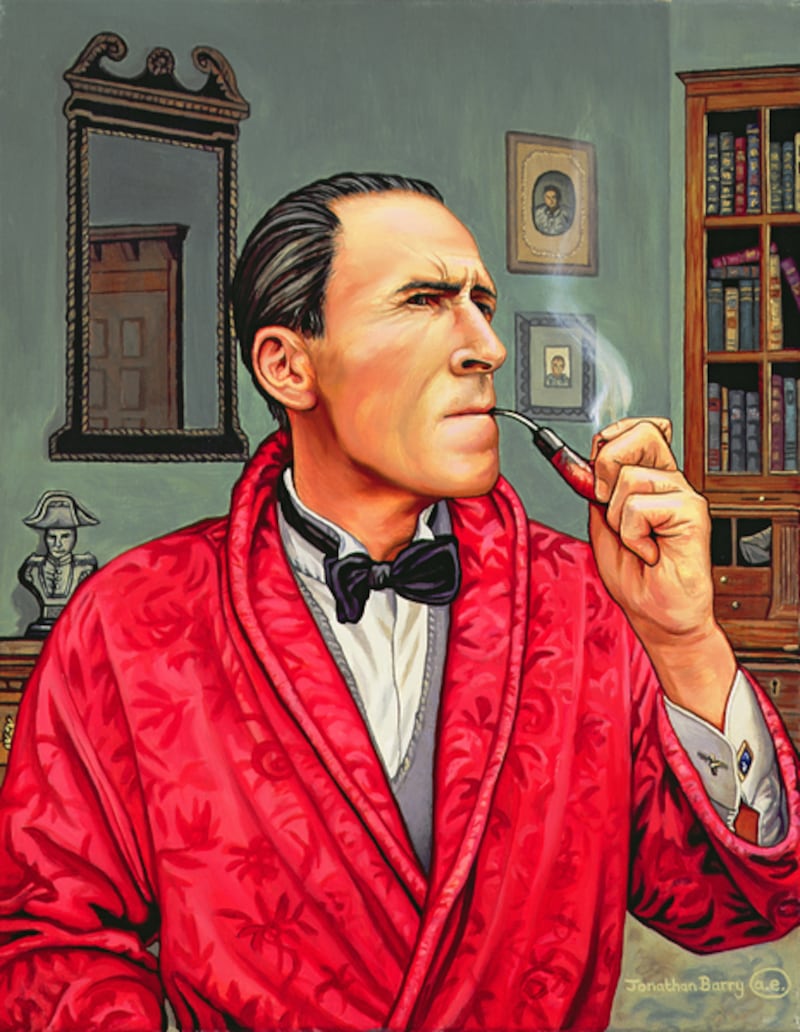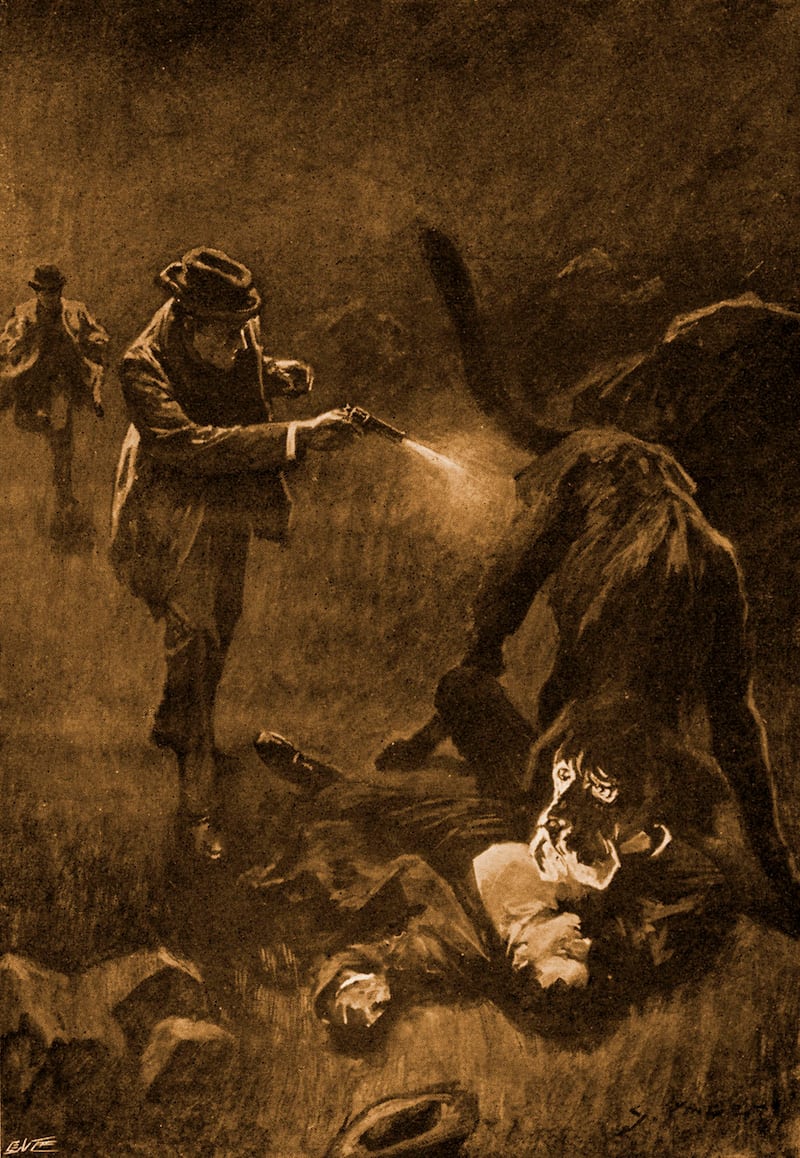Arthur Conan Doyle was born to write, becoming one of the greatest storytellers of his generation. Words, plots and characters poured from his pen like a divine gift. No matter what the subject matter he would present it in his own inimitable, effortless style, the main hallmark of which was his eminently readable prose.
It was once remarked by a 20th-century critic that if Conan Doyle had been asked to write a phone directory it would have been the most beautifully written in the world – and I know exactly what he meant.
Of the 60 Sherlock Holmes stories that he wrote, undoubtedly the most famous is The Hound of the Baskervilles. It is one part a Gothic horror story, and one part a detective thriller mystery. It boasts a clever plot, an unforgettable haunted setting on the marshes of Dartmoor, an atmosphere of intense terror, superb dialogue, and the greatest sleuth of them all – Mr Sherlock Holmes – at his scintillating best.
When he was preparing to write the novel, Conan Doyle was determined to locate it in a landscape that was dark, wild and filled with superstition. To this end he visited and spent considerable time researching in Dartmoor in Devon. It was here that he found the perfect location for his yarn complete with local legends steeped in folklore.

For example, it was Conan Doyle’s friend Bertram Fletcher Robinson who introduced him to the legend of Squire Richard Cabell (a real person), who lived at Brook Hall (a real place), in the parish of Buckfastleigh in Devon. Cabell was a delinquent aristocrat with a dire reputation for drinking, hunting, womanising and violence. It was even rumoured that he murdered his own wife. When he died in 1677, local wagging tongues said that he had sold his soul to the Devil, and legend has it that on the night of his burial a band of unruly monstrous hounds came across the moors howling and baying outside his tomb. From that day forward Cabell’s spectre was said to be seen and heard roaming the moors with his hounds, on the anniversary of his death.
Conan Doyle thought this was a superb fable, and he adapted and used it readily for his own fictional legend of Sir Hugo Baskerville (which forms the basis of the supernatural plot in his novel). In Chapter 2, when Dr Mortimer visits Holmes at his Baker Street rooms, he unveils an old manuscript which outlines in colourful detail the Curse of the Baskervilles, brought about by the dastardly deeds of Sir Hugo. The only difference between the real Cabell legend and the fictional one in the book, is that instead of using a whole pack of ghostly hounds – Conan Doyle chose a single “enormous coal-black hound” for his monster.
Having settled on this phantom beast he then turned his attention to finding a suitable manor or hall that would provide inspiration for his own invented Baskerville Hall. Once again Conan Doyle’s excellent research in Devon turned up the perfect location – this time the gloomy ruins of Fowelscombe Manor (which still exist today) in the parish of Ugborough.
When I was preparing my own research for illustrating The Hound of the Baskervilles I went to the trouble of visiting Fowelscombe Manor myself (I was living and working in London at the time) to see if indeed there was a resemblance between this building and what is described in the book.
In Chapter 6, for instance, while travelling in a carriage with Dr Mortimer and Henry Baskerville – Watson gives us a clear depiction of Baskerville Hall. He says: “The avenue opened into a broad expanse of turf, and the house lay before us. In the fading light I could see that the centre was a heavy block of building from which a porch projected. The whole front was draped in ivy, with a patch clipped bare here and there where a window or coat of arms broke through the dark veil. From this central block rose the twin towers, ancient, crenellated and pierced with many loopholes. A dull light shone through heavy mullioned windows, and from the high chimneys, which rose from the steep, high angled roof there sprang a single black column of smoke.”
The significance of me reproducing the above passage is just this: having stood before the ruins of Fowelscombe Manor I can confirm that it is indeed approached by a stretch of open grass, it does too have a porch projecting from the center, it is entirely covered by ivy, there are twin towers, they are crenellated, and the chimneys are steep. All of which proves that Conan Doyle's research was quite thorough, helping to give the reader a sense that the landscape and world they had entered was real. In fact the vividness of his descriptions has a cinematic quality which our imaginations can easily visualise.
I alluded earlier to Conan Doyle’s achievement in building up an atmosphere of simmering terror in the story. He did this by employing a masterful technique at key moments in the narrative. This involved using light and darkness to create dramatic effects in much the same way as an experienced artist uses his palette to portray the shadows and highlights in a painting.
One could argue that the whole of The Hound of the Baskervilles can be read as a battle between the dark forces of primordial evil and the bright shining light of scientific progress. This clever play on light is delightfully demonstrated in Chapter 9, when a terrified Watson and Henry Baskerville are out tracking the escaped convict and murderer Selden.
In the heavy black of night they cross the moor armed with revolvers towards Cleft Tor, where they believe he is hiding. In the distance Watson spies a small flickering light and describes it vividly. He says: “There is nothing so deceptive as the distance of a light upon a pitch-dark night, and sometimes the glimmer seemed to be far away upon the horizon and sometimes it might have been within a few yards of us. But at last we could see whence it came, and then we knew that we were indeed very close. A guttering candle was stuck in a crevice of the rocks…...Over the rocks, in the crevice of which the candle burned, there was thrust out an evil yellow face, a terrible animal face, all seamed and scored with vile passions. Foul with mire, with a bristling beard and hung with matted hair, it might well have belonged to one of those old savages who dwelt in the burrows on the hillsides.”
This is just one of several dramatic episodes in the book using light and shade to great effect.
One of the other fine skills that Conan Doyle excelled in was his precise, clear and mellifluous dialogue. This is especially noticeable in the exchanges between Holmes and Watson, which are often engaging, sometimes barbed, and occasionally profound or moving. Holmes never minces his words, and despite his seemingly cold aloofness we do get to see a more human side of him in this dark saga.
In Chapter 12 when he is convinced that the diabolical hell-hound may have a human accomplice, he speaks with passion and even tenderness to Watson of what he fears may happen. He says: “ ‘It is murder, Watson – refined, cold-blooded, deliberate murder. Do not ask me for particulars. My nets are closing upon him, even as his are upon Sir Henry, and with your help he is already almost at my mercy. There is but one danger which can threaten us. It is that he should strike before we are ready to do so. Another day – two at the most – and I have my case complete, but until then guard your charge as closely as ever a fond mother watched her ailing child.”
Equally, when called upon to deliver the horror Conan Doyle does not disappoint us. In one of the most hair-raising scenes to come out of a novel, the appearance of the spectral beast in Chapter 14 is deliciously served up. Peering through a bank of fog Watson describes the moment: “I sprang to my feet, my inert hand grasping my pistol, my mind paralysed by the dreadful shape which had sprung upon us from the shadows of the fog. A hound it was, an enormous coal-black hound, but not such a hound as mortal eyes have ever seen. Fire burst from its open mouth, its eyes glowed with a smouldering glare, its muzzle and hackles and dewlap were outlined in flickering flame. Never in the delirious dream of a disordered brain could anything more savage, more appalling, more hellish, be conceived than that dark form and savage face which broke upon us out of the wall of fog.”

Of course it is impossible to mention the above scenes without making some mention of Sidney Paget, the original illustrator of The Hound of the Baskervilles. He was the first artist in the world to depict these episodes and I would encourage any first-time reader to buy an edition that includes his artwork.
His black and white pen and ink drawings are powerful in their brooding Gothic overtones and enrich the reading experience considerably. Paget was the first person in the world to visualise what Holmes looked like, and it was he (not Conan Doyle) who gave Sherlock his deerstalker hat. Incredibly, in all 60 of Holmes’s adventures Conan Doyle only ever described him as wearing “a soft felt cap”. The deerstalker was entirely Paget’s invention.
Finally, there has been a plethora of movies and TV adaptions over the last one hundred years. But I would certainly recommend the 1988 movie starring Jeremy Brett as Holmes and Edward Hardwicke as Watson. It is beautifully produced, with stellar performances from the leads, and is completely faithful to the story and it’s dialogue. And Brett more than any other actor in the world most closely resembles Paget’s facial depiction of Holmes. Savour the adventure.


















